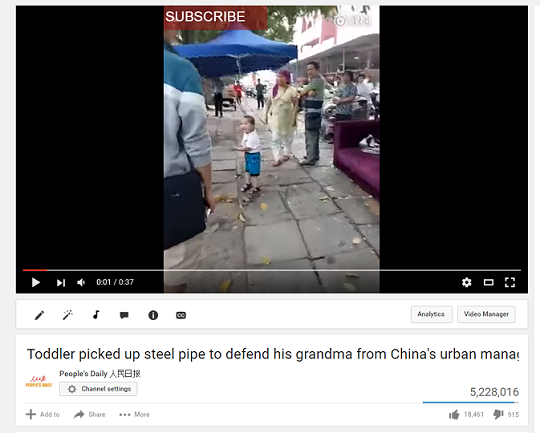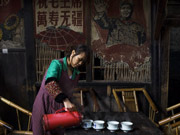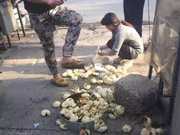

Upholding the dialectical unity of tradition and innovation, i.e., maintaining TCM's characteristics while actively applying modern science and technology in TCM development. A system has been established to carry forward the theories and clinical experience of well-known veteran TCM experts, and efforts have been made to rediscover and categorize ancient TCM classics and folk medical experience and practices. A system of technological innovation has been established to advance TCM progress, and efforts have been made to carry out systemic research on the fundamental theories, clinical diagnosis and treatment, and therapeutic evaluation of TCM. Interdisciplinary efforts have been organized in joint research on the treatment and control of major difficult and complicated diseases and major infectious diseases, as well as research on the prevention and treatment of common diseases, frequently occurring diseases, and chronic diseases using TCM. Endeavor has been made in the R&D of new TCM medicines, and medical devices and equipment.
Making overall plans for integrated, coordinated and sustainable development of TCM. The state makes overall plans for the coordinated development of TCM, integrating such areas as TCM clinical practices, healthcare, R&D, education, industry, and culture. Efforts have been made to improve community-level TCM services and the TCM medical care system. A health promotion project featuring preventative treatment of diseases has been launched to enhance TCM medical care. China has built research bases for TCM clinical studies, developed a system of coordination and innovation for the prevention and treatment of major diseases with TCM, and launched programs for training professionals necessary for TCM inheritance and innovation, and improving the quality of the ranks of TCM workers. The state has set out to promote the green development of the entire TCM industrial chain, and vigorous efforts have been made in the development of non-pharmacological therapies. Further efforts have been made to upgrade the TCM industry and develop it into an emerging strategic industry. A nationwide program has been conducted to promote the core values of TCM.
Promoting TCM development by way of government support and multi-party participation. The government has made TCM an important component of economic and social development, and has included it in relevant plans and provided financial support. The state has strengthened the supervision and administration of TCM practices, and initiated a market access system for TCM practitioners, TCM medical institutions, and TCM medicines, and improved the standards for the quality and safety of TCM service. The government has developed preferential policies to let the market play a full and decisive role in allocating resources, and is striving to create a market environment characterized by equal participation and fair play, so as to maximize the potential and vitality of TCM. Encouragement has been given to social capital to support the development of TCM, and to private investors to establish TCM healthcare institutions.
III. Carrying Forward the Tradition and Ensuring the Development of TCM
Establishment of a TCM medical care system covering both urban and rural areas. An urban TCM medical care network, mainly comprising hospitals for TCM (including ethnic minority medicine and integrated Chinese and Western medicine), TCM clinics and general hospitals' TCM clinical departments, and community health centers, has been formed. A rural TCM medical care network has been established, mainly composed of county-level TCM hospitals, TCM clinical departments of general hospitals (specialized hospitals and maternal &child health centers), TCM departments of township-level health centers, and village health clinics, which provides basic TCM healthcare services.
Statistics collected at the end of 2015 show that there were 3,966 TCM hospitals across the country, including 253 hospitals of ethnic minority medicine and 446 hospitals of integrated Chinese and Western medicine; there were 452,000 practitioners and assistant practitioners of TCM (including practitioners of ethnic minority medicine and integrated Chinese and Western medicine); there were 42,528 TCM clinics, including 550 for ethnic minority medicine and 7,706 for integrated medicine; there were 910 million visits that year to TCM medical and health service units across the country and 26,915,000 inpatients treated.
In addition to making contribution to the prevention and treatment of common, endemic and difficult diseases, TCM has played an important role in the prevention and treatment of major epidemics and medical relief in public emergencies and natural disasters. The contribution of TCM and integrated Chinese and Western medicine in treating SARS (severe acute respiratory syndrome) has been affirmed by the World Health Organization (WHO). TCM treatment of influenza A virus subtype H1N1 has yielded satisfactory results, arousing widespread attention in the international community. In addition, TCM has made distinctive contributions to the prevention and control of epidemics such as HIV/AIDS (Human Immunodeficiency Virus and Acquired Immune Deficiency Syndrome), HFMD (Hand, Foot and Mouth Disease), and Influenza A virus subtype H7N9 in humans, as well as to medical relief following the Wenchuan earthquake, the Zhouqu mudslide and other public emergencies and natural disasters.
 |  |

 Who Will Fit The Chinese Roles In Game Of Thrones?
Who Will Fit The Chinese Roles In Game Of Thrones? China's Hubei Shennongjia added to World Heritage List
China's Hubei Shennongjia added to World Heritage List Cute Dog At Fruit Stand Becomes Latest Internet Sensation
Cute Dog At Fruit Stand Becomes Latest Internet Sensation Top 10 livable Chinese cities
Top 10 livable Chinese cities The last primitive tribe in China
The last primitive tribe in China China's first intelligent security robot debuts in Chongqing
China's first intelligent security robot debuts in Chongqing A Total of 3,552 Subscribers Vanish In Two Days; YouTube Closes All Doors to Users’ Inquiries
A Total of 3,552 Subscribers Vanish In Two Days; YouTube Closes All Doors to Users’ Inquiries Out of this world! Futuristic UFO-shaped yacht has its own garden and a stunning underwater viewing deck
Out of this world! Futuristic UFO-shaped yacht has its own garden and a stunning underwater viewing deck An old tea house in Chengdu
An old tea house in Chengdu Furious Customer Crushes All the Buns from Vendor Just Because He Was Given the Wrong Flavor
Furious Customer Crushes All the Buns from Vendor Just Because He Was Given the Wrong Flavor